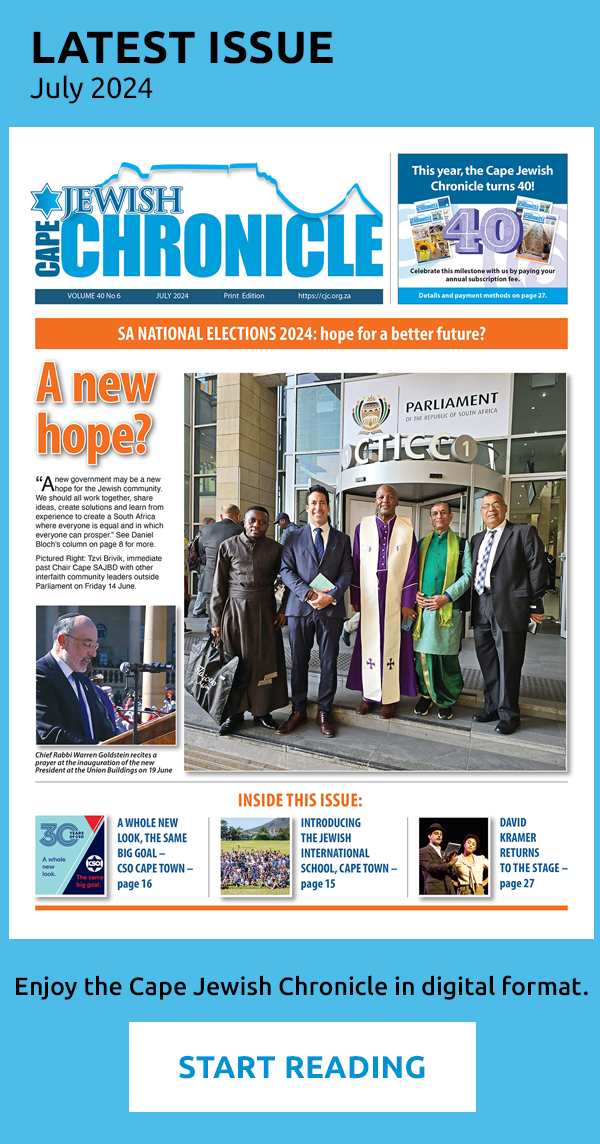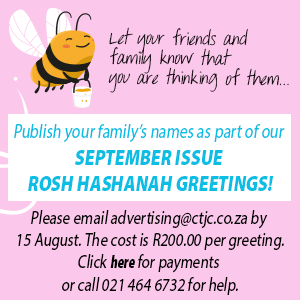By Gwynne Robins
The name Okiep, originally O’okiep, comes from the Khoikhoi word U-gieb meaning ‘large brackish place’.
It has a brackish spring, beautiful spring flowers and copper. In the 1870s it was thought to be the richest copper mine in the world with a railway line built from Okiep to Port Nolloth in 1866, with mules pulling the train because there was not enough water for a steam engine.
Mines attract economic opportunities, and economic opportunities attract poor Jewish immigrants wanting to earn a living even if the place is as hot, dry and arid as Namaqualand. The first smous to arrive in Namaqualand in 1881 was Moses Schur from Chavidan. It was said that the first time he came, he was on foot with a pack on his back. The next time, the pack was on a donkey. The following year, both man and pack were on a cart with two donkeys, and the next year, he opened a shop in Bowesdorp, later expanding into Okiep and other villages. His daughter Clara, who was born in Okiep, later joined the Jewish Joint in Paris, Budapest and Prague in post-Holocaust Europe working in DP camps, assisting survivors, and aiding illegal immigration into Palestine. The Joint had to hastily evacuate her when they were tipped off that she was about to be arrested as a spy and smuggler, as the Hungarians decided the Joint was a front for the Protocols.
In 1890, Joseph Dembitzer from Cracow arrived in Namaqualand and started the first store in Springbok, Okiep and other villages. By 1898, the economic success of Jews was attracting antisemitic attention, and John X Merriman, later Cape Premier, while canvassing votes in Okiep, criticised Jews in a speech at a banquet in honour of Jan Hofmeyr of the Afrikaner Bond, whose support Merriman wanted.
Then came the South African War, and Okiep’s copper mines, defended by 700 British soldiers, was besieged for 30 days by Boer forces under Jan Smuts. The Jewish traders had a tough time, as both sides looted their shops and they were forbidden by the British to trade with the Boers. Dembitzer, Schur and other Jewish shopkeepers required passes. Schur, who was fined £500 for trading with the Boers, said he would have been a fool not to, as the Boers paid him while the British only offered future compensation. Dembitzer’s shop was looted and his naturalisation papers stolen.
In 1904, there were only 40 Jews (including two women) living in the whole of Namaqualand. In his memoirs of pre-1914 District Six, Harry Schrire recalls the arrival of Namaqualand bochers for Rosh Hashanah. They could be easily “recognised by their large-brimmed hats, yellow boots, very shy and raw nature,” and they were made welcome by the shammes and fathers of marriageable daughters. Sometimes they were found to have a wife in der heim.
The numbers had risen to 135 by 1918 when copper prices dropped, Okiep copper mines closed and the place almost became a ghost town, with 113 Jews in the whole of Namaqualand by 1922. Later, when prices rose again, mining was resumed.
The earliest Jewish traders were religious and Zionist and had a significant impact on the growth of businesses like Trencor and the Lewis chain of stores, which operated not only in the area but in the whole of South Africa.
One of the first things a Jewish community does is to establish a cemetery, and a Jewish cemetery was opened in Okiep, the first funeral taking place in 1913 followed by one in 1918. The first High Holy Days services in Namaqualand were also held in Okiep in 1917, with Mr Pasvolsky officiating — people came from all the neighbouring villages. The next year, the Namaqualand Hebrew congregation was formed with a catchment area covering several hundred miles. Three people from Okiep were on its committee: B Albert, JC Kaplan and S Hurwitz. In 1919, the congregation donated money to the Palestine National Restoration Fund, the Cape Relief Fund for Jewish War Victims and the Hebrew University Building Fund. During the years, they contributed annually to 10 different charities.
Their synagogue was in Springbok, 8km from Okiep, in the first Dutch Reformed Church (built in 1877 as a dance hall). This was available as the new dominee, regarding the building as immoral, insisted that his flock build him a new church. Boris Saharin became the reader and Jack Sovijnsky, a former choir boy at the Roeland Street Shul, the cantor. People would gather outside the hall to listen to him sing. The first official High Holy Days services were held in 1922 (although a photo exists of a 1919 service, taken on the second day of Rosh Hashanah).
With the approval of the Cape Copper Company, the congregation obtained the land next door to the original synagogue and built their new synagogue, having accepted a quote of £3 724 from M Klawansky, with shul chairman David Gelb laying the foundation stone. It opened in time for Rosh Hashanah 1929 and could seat 80 men, with 40 women in an upper gallery. There were boxes for the rabbi and the chairman, wooden benches in front of the raised bimah, further benches at the sides and room at the back for additional chairs if required. During High Holy Days, a special cantor was imported from Cape Town. Okiep being so close to Springbok, they were in effect one community with a synagogue in the one centre, the cemetery in the other. They had an active Namaqualand Women’s Zionist Society which started in the early 1930s, whose raffles and annual Zionist Balls attracted Jews and non-Jews, with music from the band started in 1927, comprising Abe Schapera, Julius Gordon, Mick Farber and Sydney Windisch.
Antisemitism was often a feature, and as early as 1924 General Manie Maritz, a Nazi sympathiser (later prosecuted for his antisemitism) told a public meeting that the poverty of the Afrikaners in Namaqualand was due to their “archenemy the Jews who come to this country with a bundle on their backs and always manage to amass a large sum of money,” so, he argued, that the Afrikaners were “virtually the servants of the Jews.” By 1936, when they appointed Rev Segal, the Grey Shirts and later the Ossewabrandwag were holding meetings in Namaqualand villages trying to pressurise the farmers to boycott Jewish stores. In September 1937, Dr Malan toured Namaqualand warning that the Jews had not heeded his warnings against an influx of Jews greater than the country could assimilate. It caused enormous friction and even English speakers felt their territory was being encroached. Yet there were only 150 Jews in Namaqualand in 1940! The Jewish Board of Deputies Country Communities Rabbi undertook regular pastoral tours, and in July 1940, Chief Rabbi Israel Abrahams visited Springbok and met with the Women’s Zionist Society. A Union of Jewish Women branch was started by Sybil Sovinsky with Thelma and Beryl Gelb as secretary and treasurer in 1951 (when there were 116 Jews in Namaqualand). The women raised funds for both WIZO and UJW and organised annual Yom Ha’atzmaut picnics on a farm.
By the late 50s, the congregation was finding it difficult to raise a minyan for the Friday evening service and Joe Jowell, the mayor of Springbok, who was known as “the Mayor who makes up a Minyan” would fly home by plane to do so.
One cannot look at the Jewish community in Okiep and Namaqualand without remarking on the major role played by the Jowell family. Joe Jowell was president of the congregation from 1959 until it closed down in 1972, with his sons Neil and Cecil acting as secretary and treasurer. When the SA Railways terminated its unprofitable road motor service in 1930, leaving the villagers without access to supplies, Joe Jowell, who had taken over the Namaqualand Chevrolet sub-agency the year before, converted an old car to a truck to fill in the gap, and this developed into a road transport business (now Trencor) which became a leading nationwide carrier in South Africa, branching out into trailer manufacturing, tyre merchandising and retreading, and container manufacturing. Joe Jowell was elected president of the South African Motor Trade Association, vice-president of the international body and served on both municipal and divisional councils.
In August 1966, tombstones in the Okiep cemetery were vandalised and a committee of residents headed by Cecil Jowell arranged for the municipality to repair the damage. The tombstones were cemented together flat and the cemetery was fenced off.
There were 65 Jews in apartheid Namaqualand in 1961, dropping to 23 by 1971 but even with so few Jews, there was still antisemitism, with Jews being accused by the Afrikaners of being “too liberal”. There was a campaign by professional rivals and a dominee, and an election slogan that read: “Don’t vote for a Jew, vote for an Afrikaner.” Despite such campaigns, Joe Jowell again topped the poll for election as Mayor in 1967, and celebrated his 30th year as Mayor with a Mayoral Sunday in the synagogue, followed by a tea party. Although the dominee urged his followers to boycott the event, the citizens attended in droves — their respect for Jowell trumping their respect for the dominee. (The dominee apologised after Jowell’s death.)
Joseph Jowell was buried in the cemetery in 1972. In 1978, there were only two Jews left in Namaqualand, Rebecca Jowell and Kurt Nussbaum.
Rebecca Jowell, who passed away in 1989, was the last Jew to be buried in the cemetery. By 1990, the Board acting on behalf of the defunct Namaqualand Hebrew Congregation donated the new and old synagogue buildings to the Springbok Town Council on condition that the municipality undertook to maintain the cemetery in Okiep.
The Country Communities Sub-committee of the Cape SAJBD looks after the cemeteries of the defunct country communities.
Contact daniel@ctjc.co.za for more information.

The new Synagogue in Springbok, now the Namakwaland Museum with Colonel David Teperson and his brother, 2007 
The gravestones of Joseph (Joe) Jowell (1905-1973) and Rebecca (Bessie) Jowell (1901-1987) 
Okiep copper mine pit 
Okiep in Spring 
The old synagogue in Springbok
Cape SA Jewish Board of Deputies website: www.capesajbd.org, Instagram, and Facebook page.
• Published in the PDF edition of the June 2021 issue – Download here.
• Sign up for our newsletter and never miss another issue!
• Please support the Cape Jewish Chronicle with a voluntary Subscription. For payment info click here.
• Visit our Portal to the Jewish Community to see a list of all the Jewish organisations in Cape Town with links to their websites.
Follow the Chronicle: Facebook | Instagram | Twitter | LinkedIn















